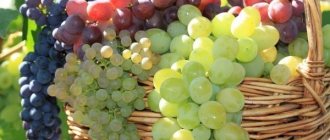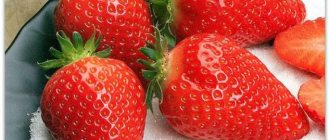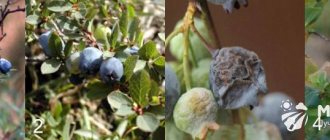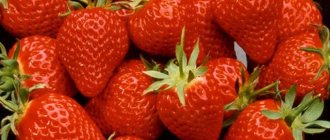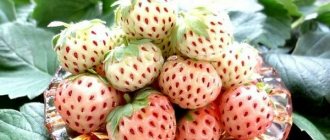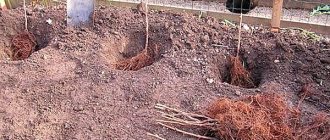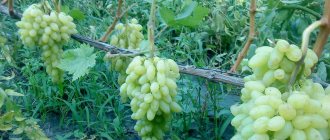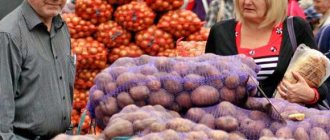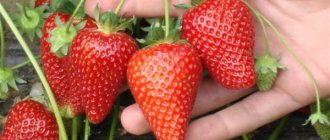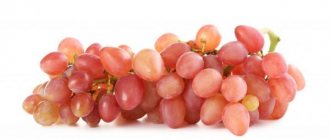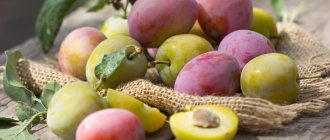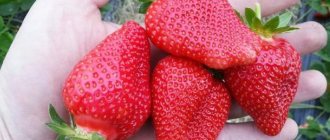Vima Zanta
This early strawberry variety is a worthy example of Dutch selection. Vima Zanta produces a good harvest of large, beautiful berries with juicy sweet pulp and a delicate aroma.
The only nuance that can stop you from choosing this variety is the “capriciousness” of the harvest during transportation. The berries survive travel only when chilled, so this variety is unlikely to suit you if you plan to grow strawberries for sale.
If during fruiting you do not remove the tendrils that form in abundance on Vima Zanta bushes in time, the berries will become smaller.
| Maturation | Berry weight (g) | Productivity (kg per bush) | Peculiarities |
| End of May – beginning of June | 40 | 0,6-0,8 | High warping |
Mid-season varieties
Mid-season strawberry varieties are valued for their resistance to temperature fluctuations. Fruiting in mid-summer has a beneficial effect on the taste of the berries, since solar activity is at its highest during this period.
CHamora Turisi
Gardeners believe that the variety was brought from Japan, but whether this is actually true remains unknown. The first berries ripen in the second half of June in warm regions, in the middle and central regions of Russia - in mid-July.
Varietal characteristics:
- The berries are fleshy, heterogeneous, bright red.
- The shape can be conical, semicircular, comb.
- The pulp has a white core and is juicy. The taste is sweet, strawberry.
- The average fruit weight is from 30 to 70 g.
- The fruiting period is from one month to two months.
With intensive care, "Chamora Turisi" is able to produce a rich harvest for 12 years. In the second or third year after planting, you can collect up to 2 kg of berries from one bush.
Subtleties of care:
- The distance between bushes when planting should be 40-50 cm.
- Plant the variety at the end of August, and in areas where winters are cold and with little snow - in May.
- Watering should be moderate. Excessive watering will cause the fruits to become watery. Lack of moisture will affect the quality: the berries will become small.
- If the summer is not dry, it is enough to water the beds once a week.
- Strawberries are prone to overgrowing. After fruiting has finished, remove the tendrils and old leaves.
The variety is susceptible to infection with fungal diseases. In spring, treat bushes with fungicides.
Vima Zanta
A young variety from Holland. A hybrid of Elsanta and Corona - standard Dutch varieties. Ripening period: end of May - mid-June (depending on the region).
Varietal characteristics:
- The berries are smooth, burgundy, even in shape. Yellowish seeds are pressed into the pulp.
- The average fruit weight is 20-30 g.
- The fruiting period is up to 3 weeks.
"Vima Zanta" does not last long. The berries wrinkle and darken during transportation. But in terms of taste, the variety has high scores: 4.5-5 points out of 5.
Subtleties of care:
- Plant bushes in early spring or autumn at a distance of 40-45 cm. The variety loves sunny areas.
- "Vima Zanta" does not tolerate drought well, so it needs regular watering.
- Alternating mineral and organic fertilizers has a positive effect on yields. The plant responds well to fertilizing. You can read about spring feeding here.
The crop is resistant to fusarium, gray rot, pest damage and powdery mildew. In good conditions, one bush produces up to 2 kg of berries.
Marshal
Marshall strawberries were developed in America at the end of the 19th century. The first berries are harvested in early to mid-June.
Varietal characteristics:
- The berries are scarlet, large, shiny.
- The shape of the fruit is wedge-shaped.
- The pulp is red, without empty cavities.
- The taste is sweet, strawberry, with a pleasant sourness.
The plant adapts well to weather conditions: it can withstand cold winters (up to 30 degrees) and dry summers.
Subtleties of care:
- Plant the seedlings in loose, light soil that allows moisture to pass through well.
- During the growing season, water your strawberries regularly. Irrigate at the root, early in the morning or in the evening.
- Loosen the ground around the bushes to provide air and moisture access to the roots.
In regions with warm climates, it is possible to harvest several times in one season. Fruiting declines in the second year, so the beds are re-planted.
Lord
The homeland of "Lord" is not known, but some sources point to Great Britain. The berries ripen in early June in the south, in mid-June in central and central Russia, and at the end of the month in the north. Fruiting lasts about a month.
Varietal characteristics:
- The berries are rich red.
- The shape is cone-shaped. The weight of the fruit reaches 100 g.
- The taste is sweet and sour, pronounced.
Lord is not a whimsical variety; it adapts to temperature fluctuations. With good care, it does not require transplantation for 10 years.
Subtleties of care:
- Plant the plant at a distance of 60-65 cm in a checkerboard pattern in illuminated areas.
- Strawberries are sensitive to humidity levels. When there is drought, the yield decreases; when there is excess moisture, the fruits do not ripen enough and rot.
- The bushes reproduce by daughter rosettes. Leave 2 powerful tendrils on annual bushes and take first- and second-order rosettes from them.
Strawberries are resistant to spotting, gray fruit rot, and powdery mildew. The application of mineral and organic fertilizers has a positive effect on the yield of the variety.
Crown
Another variety from Dutch breeders. Characterized by excellent taste. Ripening time: early to mid-June (depending on climate).
Varietal characteristics:
- The berries are dark red, glossy.
- The fruits are elongated, average weight 20-30 g.
- The taste is pronounced, strawberry, sweet. Rating on a 5-point scale 5 points.
The crown tolerates frost well. The bushes are not covered for the winter.
Subtleties of care:
- The best time for planting is the beginning of May and the period from August to September. The distance between bushes is 40-50 cm.
- “Crown” loves organic fertilizers (ash, humus, urea) and mineral fertilizers (nitrogen, potassium, phosphorus). Apply fertilizers before flowering and after the growing season.
- Due to excessive whisker formation, prune in the fall.
- The variety is demanding on moisture. Irrigate the beds by drip.
Strawberries are not resistant to gray rot and blight. For prevention, treat bushes with special compounds.
Black Prince
The variety was bred in Italy; today it is successfully grown not only in garden plots, but also on large farm lands. Fruiting is long - from mid-June to August-September.
Varietal characteristics:
- The berries are dark burgundy, large (30-50 g).
- There are many seeds on the surface of the berries. The shape is cone-shaped.
- The taste of the fruit is sweet, strawberry, with a slight sourness.
A high-yielding variety - one bush produces up to 1.5 kg of berries.
Subtleties of care:
- Black Prince grows well in light, breathable soils. The distance between bushes is 50 cm.
- Water your strawberries regularly. During flowering, irrigate only at the root. After watering, loosen the soil.
- In spring, feed with phosphorus fertilizers. During the ripening of berries, fertilize with complex mineral supplements.
Black Prince is in demand on the market, as the berries are beautiful and tasty and retain their marketable appearance for a long time.
Holiday
Strawberry breeders from the USA. Mid-late variety, ripens at the end of June.
Varietal characteristics:
- The berries are light red.
- The shape is round and regular.
- The taste is dessert, sweet and sour.
- The berries will ripen almost simultaneously. Average weight – 30-35 g.
Subtleties of care:
- Strawberries are grown in sunny areas in light, breathable soil. The width between rows is 40 cm.
- Drip watering. To keep the berries sweet and less watery, do not water the plant excessively before harvesting.
- In spring, apply mineral fertilizers containing potassium, nitrogen, and phosphorus.
- Before wintering, cover the strawberry beds with hay (straw) or spruce branches.
Productivity is high (1-1.5 kg per bush). Every year the berries become smaller, but retain their marketable appearance.
Gigantella
The name of this strawberry - Gigantella - speaks for itself. Its fruits can reach a record weight of 125 g! At the same time, the pulp is very juicy, but quite dense, sweet with light pineapple notes.
Unlike the previous variety, this one retains its shape during transportation, so it can easily be grown for commercial purposes. Such a beauty will definitely find her buyer!
| Maturation | Berry weight (g) | Productivity (kg per bush) | Peculiarities |
| June | 60-125 | 1-3 | Good transportability |
Diamond
Diamond is an American garden strawberry variety that will turn 20 years old next year. During this time, strawberries managed to win a considerable number of fans on both sides of the Atlantic.
Diamond fruits are medium-sized, tasty, aromatic. The bushes are practically not susceptible to powdery mildew, spotting, verticillium and root rot.
| Maturation | Berry weight (g) | Productivity (kg per bush) | Peculiarities |
| End of May – beginning of June | 20-40 | 1-2 | Resistant to diseases and viruses |
Varieties for growing in the middle zone
Select varieties that are resistant to return frosts, capable of yielding crops during the rainy season, and that can withstand long periods of time without solar heat. Plants must be resistant to fungal diseases.
Sudarushka
Early ripening. It has increased frost resistance and is not affected by viral and bacterial diseases. Forms semi-spreading bushes with light pink tendrils. The berries (from 13 to 35 g) are scarlet, ovoid, and do not become smaller towards the end of fruiting. The pulp has a dessert taste.
Clery
It bears fruit early and does not freeze. Small bushes with pubescent peduncles. Valued for its large berries with a carmine color. Ripening begins from the bottom to the tips. In the first year, “Clery” strawberries do not show much yield, but in the next season they increase fruitfulness and vine formation.
Asia
Many rosettes grow on compact bushes. The declared yield of strawberries “Asia” is up to 1.5 kg. Does not freeze, requires treatment against anthracosis and powdery mildew. Scarlet fruits up to 35 g with a dense structure, reminiscent of watermelon pulp.
Irma
Medium-sized remontant bushes. The average parameters of elongated fruits are 38 g, sometimes 54 g are found. The first harvest is harvested in early June, the harvest ripens for another two months. Even in rainy weather, the berries do not rot and remain sweet.
Ducat
This variety is not afraid of return frosts. Unlike most varieties, Dukat bears fruit well even after a sudden cold snap. This variety is also notable for its excellent yield and wonderful, refined taste.
The berries can be consumed fresh or processed. They retain their aroma no matter how they are cooked.
| Maturation | Berry weight (g) | Productivity (kg per bush) | Peculiarities |
| End of May – beginning of June | 20-40 | 1-2 | Resistant to low temperatures |
Kent
The Canadian variety Kent celebrates its 35th anniversary this year. This strawberry has proven itself well among gardeners. Of course, in terms of large fruit, it cannot be compared with Gigantella, but, nevertheless, Kent’s berries can be called quite weighty.
In addition, strawberries of this variety have an excellent dessert taste, are well stored and transported. In general, Kent can be called one of the most unpretentious varieties of garden strawberries.
| Maturation | Berry weight (g) | Productivity (kg per bush) | Peculiarities |
| First half of June | 40 | 0,7-1 | Winter hardiness, resistance to powdery mildew and gray rot |
Bearless strawberry
The beardless varieties are compact in size, do not grow mustache, and produce crops before frost. They are distinguished by productivity, winter hardiness, and low maintenance requirements. Although the seeds are small, they allow you to grow a plantation of seedlings:
- Yellow miracle - small yellow cone-shaped fruits that taste like pineapple;
- Ruyana - tolerates rainy weather, is resistant to rot, can be grown even in the shade;
- Rügen Island - bushes with good foliage, used to decorate the site.
Clery
Strawberry Clery is an Italian beauty with a magnificent sweet taste without a single sour note. Bushes of this variety rarely get sick and are quite resistant to fungus and rot, but it is still recommended to grow them under cover in the middle zone.
| Maturation | Berry weight (g) | Productivity (kg per bush) | Peculiarities |
| The beginning of June | 20-40 | 0,7-1 | Resistance to fungus and root diseases |
Queen Elizabeth II
This variety is the absolute champion among strawberry varieties. This garden strawberry produces large fruits with a truly royal taste. The berries are sweet, a little honey-like. True, provided that you harvest a ripe harvest. Unripe fruits may become sour.
Queen Elizabeth II is a remontant variety that blooms and bears fruit from May to October. She doesn't even care about frost. Do not hesitate to plant bushes of this variety in your garden!
| Maturation | Berry weight (g) | Productivity (kg per bush) | Peculiarities |
| Remontantnaya (from May to October) | Up to 110 | 1-2 | Resistance to most diseases and viruses |
How to choose a strawberry variety
When choosing a variety, first of all pay attention to the requirements for climatic conditions. Some plants cannot tolerate heat, while others die during frosts. Some are weakly resistant to drought, others to rainy weather.
For those who like to make jam, varieties with small, medium-density berries are suitable. Large and dense fruits are good for freezing and making desserts.
Are you planning to grow berries in a greenhouse and are you wondering which strawberries produce crops all year round? Pay attention to the varieties Elizabeth 2, Temptation and San Andreas.
For growing in open ground, it is best to select several varieties with different ripening periods and one or two remontant ones. This way you can enjoy fresh strawberries longer and at the same time understand which berries grow best in your area.
Olvia
Ukrainian strawberry Olvia is a real beauty. Its fruits are large, glossy, and regular in shape. Even though the yield of Olvia does not break records, plants of this variety are not afraid of the vagaries of the weather - they are not afraid of either frost or drought.
| Maturation | Berry weight (g) | Productivity (kg per bush) | Peculiarities |
| Mid-May – mid-June | 30-40 | 0,6-0,7 | Frost resistance, drought resistance |
Late ripening
These varieties begin to bear fruit from mid-July and continue to bear fruit for a month. Typically, late varieties are dark and large, with a rich strawberry flavor and aroma.
Malvina
German selection. A variety with a pronounced sweet taste. Pros:
- the berry is quite large - 20-30 grams;
- The bush is also large, the plant is easy to care for.
Minuses:
- with insufficient watering, the berries become smaller;
- When there is too much sun, it loses its juiciness.
The berries are dark red, conical in shape.
Bohemia
Russian late variety of strawberries. The fruits are dark and shiny. Pros:
- resistance to pests and infections;
- bright strawberry taste with sourness;
- easy to transport.
Minuses:
- berries often grow together;
- they become smaller towards the end of the harvest.
The berries are large, the greenish tip quickly turns red, but, being green, it does not impair the taste of the fruit.
Pegasus
He is originally from England. The berries are medium-sized, weighing up to 20 grams, conical, bright red. Advantages of the variety:
- productivity;
- disease resistance;
- safety of fruits during transportation.
The disadvantages include:
- insufficient winter hardiness;
- may be affected by powdery mildew.
Berries with excellent commercial characteristics. The variety is high-yielding.
Honey
Honey is one of the most popular varieties of garden strawberries in its homeland in the USA. Our gardeners also like American strawberries. And this is not surprising, because Honey has a lot of advantages. Firstly, it is perfectly “rehabilitated” after return frosts. Secondly, this strawberry is easy to care for. Thirdly, it is easily transported.
| Maturation | Berry weight (g) | Productivity (kg per bush) | Peculiarities |
| Mid-May – mid-June | 30-40 | 0,5-0,7 | Frost resistance, good transportability |
How and what to fertilize strawberries to get a big harvest
Strong bushes produce a harvest no matter what. These are bushes 3 and 4 years old. Strawberries are fertilized with humus and compost in autumn or early spring. And nitrogen fertilizers - in early spring before the first loosening of the soil.
And during the season we alternate and add a compost solution or rotted manure / fertilizers for berry crops and a full complex of mineral fertilizer. It contains balanced microelements such as phosphorus, magnesium and nitrogen. On neutral soils, strawberries lack nitrogen most of all. Therefore, we select appropriate fertilizers containing it.
Try not to overfeed the plants, otherwise you will have a massive increase in green mass, but the fruits will not set. Fertilize strawberries strictly in accordance with the dosage (on the fertilizer pack) no more than once every 10-14 days. We pour 0.5 liters of fertilizer solution under each bush, and then water the strawberry plantings well.
In the spring, you can also fertilize the strawberry beds with wood ash. It does not contain nitrogen, but contains up to 30 elements: potassium, calcium, magnesium, iron, silicon, phosphorus, sulfur, boron, manganese, etc. Natural fertilizer is always better than chemical fertilizer. Ash also successfully fights pests and provides prevention against rot. You can add it to the soil and loosen it, or you can dilute it with water and water the beds.
After fruiting, strawberries need to be processed, dry leaves removed, shoots cut off and fed with compost or rotted manure. In this way, the plant will prepare for winter and lay new buds for the next season.
Be sure to plant one of the listed varieties of strawberries or any other medium-ripening variety in your garden - and reap the most delicious harvest of this wonderful berry.
